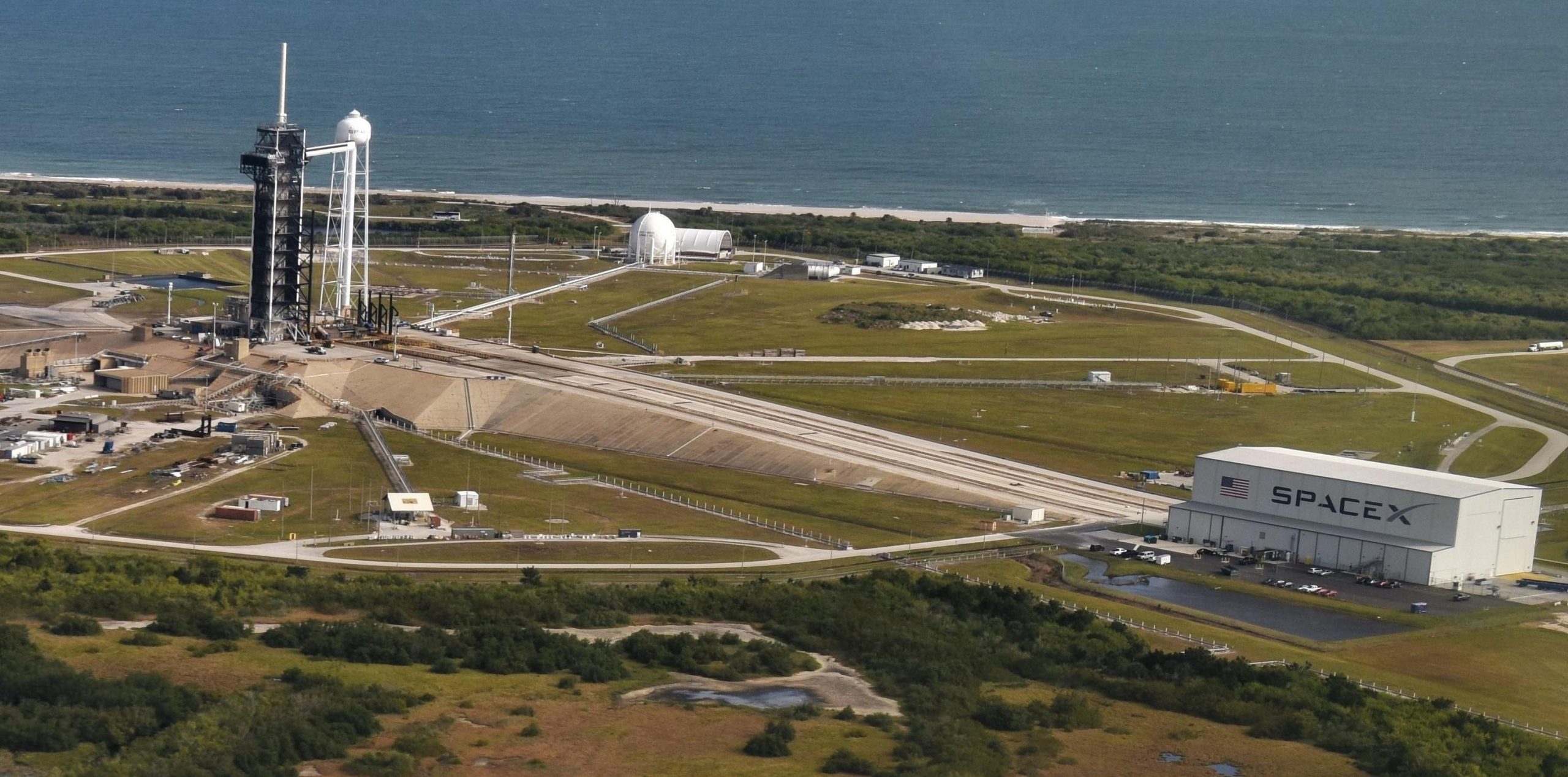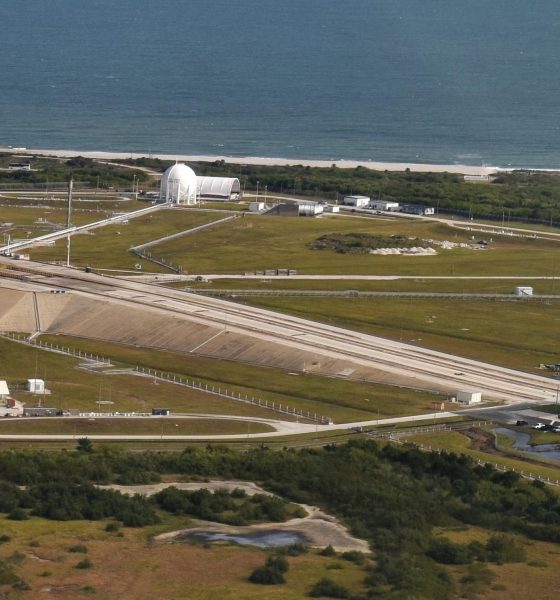

News
SpaceX is building Starship’s East Coast launch site at a breakneck pace
After breaking ground on September 21st, SpaceX and construction contractors are working at a breakneck pace to complete the modifications necessary for the existing Launch Complex 39A pad to support East Coast Starship and Super Heavy launches.
SpaceX is simultaneously preparing two launch sites and two orbital-class Starship prototypes – Mk1 (Boca Chica, Texas) and Mk2 (Cocoa, Florida) – for their inaugural flight tests. Both pads and flight hardware appear to feature unique design choices and clearly have different strategic value, but one thing remains entirely consistent: SpaceX is not wasting time at either site.
Less than five days after SpaceX received its final construction permit and broke ground at Pad 39A, the company and its contractors have made quick work of clear the ground. Major earthmoving is well underway, concrete deliveries have already begun, and piles are being driven in a bid to quickly secure the proposed Starship launch mount’s foundation.
Per descriptions and drawings included in environmental assessments and water management documents published in August and September, SpaceX – already leasing and operating out of Pad 39A – intends to modify the NASA-owned Kennedy Space Center (KSC) facilities. Once complete, Pad 39A will be able to simultaneously support both Falcon 9/Heavy and Starship/Super Heavy launches. Per communications archived as part of St. Johns River Water Management District (SJR) permitting, SpaceX also needed NASA approval to attain the stormwater management permits needed to begin its Pad 39A modifications.
The fact that SpaceX has already broken ground guarantees that NASA and KSC have already given SpaceX full permission to do so, meaning that the path to complete Pad 39A’s Starship launch accommodations is nearly wide open. The only thing SpaceX still needs – assuming the company hasn’t already received approval – is one last major permit in the form of a positive National Environmental Policy Act (NEPA) environmental assessment (EA), the final draft of which was published on August 7th. SpaceX can technically continue construction but it will need to secure NEPA approval before it can begin any sort of Starship operations at the new facilities.
Meanwhile, although it’s pretty clear that a large portion of SpaceX’s Cocoa, FL Starship crew has been diverted to help with Mk1 in Texas, a skeleton crew continues to do what they can to prepare Starship Mk2 for its next major assembly milestones. Most notably, the prototype’s upper (top) tank dome was rolled out of the facility’s assembly building, a strong indicator that it’s nearly ready for installation atop Starship Mk2’s tank section. This will ‘cap off’ Starship Mk2, a milestone its sister ship reached on September 14th. As such, Mk2 is likely two or so weeks behind Mk1 after suffering delays at the hand of Hurricane Dorian and after CEO Elon Musk likely decided to prioritize Starship Mk1’s pre-presentation preparations.
Most importantly, a few local observers have noted and continued to document the process SpaceX will have to undertake to transport Starship Mk2 from Cocoa to Cape Canaveral – specifically Pad 39A. Several people realized that a nearby railroad bridge’s imminent construction could shortly block the path SpaceX was hoping to use to get Starship to the Indian River, where a barge could carry it the rest of the way to KSC. SpaceX likely has backup routes as options, but they would very likely require far more time and effort.
Time will tell if SpaceX can prepare Starship Mk2 in time to take its original transport route. By all appearances, if the prototype’s transport ends up being delayed, Pad 39A’s newly minted Starship launch facilities will likely be ready and waiting once the rocket arrives.
Check out Teslarati’s Marketplace! We offer Tesla accessories, including for the Tesla Cybertruck and Tesla Model 3.

Elon Musk
Elon Musk’s X will start using a Tesla-like software update strategy
The initiative seems designed to accelerate updates to the social media platform, while maintaining maximum transparency.

Elon Musk’s social media platform X will adopt a Tesla-esque approach to software updates for its algorithm.
The initiative seems designed to accelerate updates to the social media platform, while maintaining maximum transparency.
X’s updates to its updates
As per Musk in a post on X, the social media company will be making a new algorithm to determine what organic and advertising posts are recommended to users. These updates would then be repeated every four weeks.
“We will make the new 𝕏 algorithm, including all code used to determine what organic and advertising posts are recommended to users, open source in 7 days. This will be repeated every 4 weeks, with comprehensive developer notes, to help you understand what changed,” Musk wrote in his post.
The initiative somewhat mirrors Tesla’s over-the-air update model, where vehicle software is regularly refined and pushed to users with detailed release notes. This should allow users to better understand the details of X’s every update and foster a healthy feedback loop for the social media platform.
xAI and X
X, formerly Twitter, has been acquired by Elon Musk’s artificial intelligence startup, xAI last year. Since then, xAI has seen a rapid rise in valuation. Following the company’s the company’s upsized $20 billion Series E funding round, estimates now suggest that xAI is worth tens about $230 to $235 billion. That’s several times larger than Tesla when Elon Musk received his controversial 2018 CEO Performance Award.
As per xAI, the Series E funding round attracted a diverse group of investors, including Valor Equity Partners, Stepstone Group, Fidelity Management & Research Company, Qatar Investment Authority, MGX, and Baron Capital Group, among others. Strategic partners NVIDIA and Cisco Investments also continued support for building the world’s largest GPU clusters.
News
Tesla FSD Supervised wins MotorTrend’s Best Driver Assistance Award
The decision marks a notable reversal for the publication from prior years, with judges citing major real-world improvements that pushed Tesla’s latest FSD software ahead of every competing ADAS system.

Tesla’s Full Self-Driving (Supervised) system has been named the best driver-assistance technology on the market, earning top honors at the 2026 MotorTrend Best Tech Awards.
The decision marks a notable reversal for the publication from prior years, with judges citing major real-world improvements that pushed Tesla’s latest FSD software ahead of every competing ADAS system. And it wasn’t even close.
MotorTrend reverses course
MotorTrend awarded Tesla FSD (Supervised) its 2026 Best Tech Driver Assistance title after extensive testing of the latest v14 software. The publication acknowledged that it had previously criticized earlier versions of FSD for erratic behavior and near-miss incidents, ultimately favoring rivals such as GM’s Super Cruise in earlier evaluations.
According to MotorTrend, the newest iteration of FSD resolved many of those shortcomings. Testers said v14 showed far smoother behavior in complex urban scenarios, including unprotected left turns, traffic circles, emergency vehicles, and dense city streets. While the system still requires constant driver supervision, judges concluded that no other advanced driver-assistance system currently matches its breadth of capability.
Unlike rival systems that rely on combinations of cameras, radar, lidar, and mapped highways, Tesla’s FSD operates using a camera-only approach and is capable of driving on city streets, rural roads, and freeways. MotorTrend stated that pure utility, the ability to handle nearly all road types, ultimately separated FSD from competitors like Ford BlueCruise, GM Super Cruise, and BMW’s Highway Assistant.
High cost and high capability
MotorTrend also addressed FSD’s pricing, which remains significantly higher than rival systems. Tesla currently charges $8,000 for a one-time purchase or $99 per month for a subscription, compared with far lower upfront and subscription costs from other automakers. The publication noted that the premium is justified given FSD’s unmatched scope and continuous software evolution.
Safety remained a central focus of the evaluation. While testers reported collision-free operation over thousands of miles, they noted ongoing concerns around FSD’s configurable driving modes, including options that allow aggressive driving and speeds beyond posted limits. MotorTrend emphasized that, like all Level 2 systems, FSD still depends on a fully attentive human driver at all times.
Despite those caveats, the publication concluded that Tesla’s rapid software progress fundamentally reshaped the competitive landscape. For drivers seeking the most capable hands-on driver-assistance system available today, MotorTrend concluded Tesla FSD (Supervised) now stands alone at the top.
News
Elon Musk’s Grokipedia surges to 5.6M articles, almost 79% of English Wikipedia
The explosive growth marks a major milestone for the AI-powered online encyclopedia, which was launched by Elon Musk’s xAI just months ago.

Elon Musk’s Grokipedia has grown to an impressive 5,615,201 articles as of today, closing in on 79% of the English Wikipedia’s current total of 7,119,376 articles.
The explosive growth marks a major milestone for the AI-powered online encyclopedia, which was launched by Elon Musk’s xAI just months ago. Needless to say, it would only be a matter of time before Grokipedia exceeds English Wikipedia in sheer volume.
Grokipedia’s rapid growth
xAI’s vision for Grokipedia emphasizes neutrality, while Grok’s reasoning capabilities allow for fast drafting and fact-checking. When Elon Musk announced the initiative in late September 2025, he noted that Grokipedia would be an improvement to Wikipedia because it would be designed to avoid bias.
At the time, Musk noted that Grokipedia “is a necessary step towards the xAI goal of understanding the Universe.”
Grokipedia was launched in late October, and while xAI was careful to list it only as Version 0.1 at the time, the online encyclopedia immediately earned praise. Wikipedia co-founder Larry Sanger highlighted the project’s innovative approach, noting how it leverages AI to fill knowledge gaps and enable rapid updates. Netizens also observed how Grokipedia tends to present articles in a more objective manner compared to Wikipedia, which is edited by humans.
Elon Musk’s ambitious plans
With 5,615,201 total articles, Grokipedia has now grown to almost 79% of English Wikipedia’s article base. This is incredibly quick, though Grokipedia remains text-only for now. xAI, for its part, has now updated the online encyclopedia’s iteration to v0.2.
Elon Musk has shared bold ideas for Grokipedia, including sending a record of the entire knowledge base to space as part of xAI’s mission to preserve and expand human understanding. At some point, Musk stated that Grokipedia will be renamed to Encyclopedia Galactica, and it will be sent to the cosmos.
“When Grokipedia is good enough (long way to go), we will change the name to Encyclopedia Galactica. It will be an open source distillation of all knowledge, including audio, images and video. Join xAI to help build the sci-fi version of the Library of Alexandria!” Musk wrote, adding in a later post that “Copies will be etched in stone and sent to the Moon, Mars and beyond. This time, it will not be lost.”








